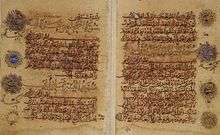Ibn al-Bawwab
| Ibn al-Bawwab | |
|---|---|
 Ibn al-Bawwab script seen here is the earliest existing example of a Qur'an written in a cursive script, Chester Beatty Library | |
| Died | 1022 |
| Known for | Islamic calligraphy |
| Movement | Naskh Thuluth muhaqqaq |
| Wikimedia Commons has media related to Ibn al-Bawwab. |
Ibn al-Bawwāb was a Persian calligrapher and illuminator who lived during the time of the Buyid dynasty. He most likely died around 1022 AD in Baghdad.[1]
Life
Ibn al-Bawwāb was from a poor family. The name he is known by means literally “son of the doorkeeper.” Nevertheless, he received a thorough education in law and is said to have known the Qurʾān by heart. Ibn al-Bawwāb’s interest in calligraphy was inspired by students of Ibn Muqlah. Altogether, Ibn al-Bawwāb reputedly produced 64 copies of the Qurʾān by hand. One of the most beautiful in the rayḥānī script is in the Laleli Mosque in Istanbul, and another is in the Chester Beatty Library in Dublin, Ireland.[2] a gift of the Ottoman Sultan Selim I (1470–1512). Ibn al-Bawwāb was recognized as a master in his own time; his school of calligraphy lasted until Baghdad fell to the Mongols more than two centuries after his death.[1]
Works
One of his largest achievements was the perfection of the al-Khatt al-Mansub (literally, the well-proportioned script) style of Islamic calligraphy. He also contributed to the development of many of the early cursive scripts including rayḥānī, naskh, tawqīʿ and muhaqqaq.[1]
References
- 1 2 3 "Ibn al-Bawwāb brief bio". Retrieved 2012-09-14.
- ↑ http://www.cbl.ie/Collections/The-Islamic-Collection/The-Qur-an-Collection.aspx